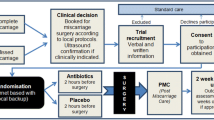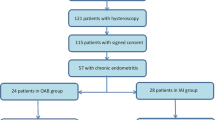Abstract
It is believed that much of the small increased risk for developing pelvic inflammatory disease (PID) associated with the use of an intrauterine device (IUD) appears to be caused by bacterial contamination of the endometrial cavity at the time of insertion. Previous research suggests that use of prophylactic antibiotics immediately prior to IUD insertion may reduce the risk of developing PID. This paper presents results from a randomized clinical trial of 1485 women in Ibadan, Nigeria evaluating the effectiveness of 200 mg of doxycycline (versus placebo) given orally at the time of IUD insertion in reducing the incidence of PID during the first three months of IUD use. Rate of PID infection in the doxycycline-treated group was not significantly lower than that in the placebo-treated group. The rate of unscheduled IUD-related visits to the clinic also was not significantly lower among the doxycyclinetreated group. However, the incidence of PID was low (21 cases) for both study groups. Aseptic conditions during IUD insertion, follow-up visits with short intervals to monitor health, and treatment of opportunistic infections may have reduced the potential of PID within this population.
Resumé
On pense qu'un bon nombre des légers risques de contracter une affection pelvienne inflammatoire liée à l'utilisation d'un dispositif intra-utérin est sans doute dû à une contamination bactérienne de la cavité utérine au moment de l'insertion. Les recherches précédentes semblen indiquer que l'administration d'antibiotiques à titre prophylactique immédiatement avant l'insertion d'un DIU peut réduire le risque de telles inflammations. Ce document présente les résultats d'un essai clinique randomisé sur 1485 femmes effectué à Ibadan (Nigéria) en vue d'évaluer l'efficacité de 200 mg de la doxycycline (comparée à un placebo), administrés par voie buccale au moment de l'insertion du DIU, pour réduire l'incidence des affections pelviennes inflammatoires pendant les trois premiers mois d'utilisation d'un DIU. Le pourcentage d'infection dans le groupe des femmes traitées à la doxycycline n'étaiet pas significativement moins élevé que celui du groupe traité au placebo. Le pourcentage de consultations imprévues à la clinique pour des raisons liées au DIU n'étaient pas non plus significativement moins élevé pour le groupe traité à la doxycycline. Toutefois, l'incidence d'affections pelviennes inflammatoires étaiet faible (21 cas) pour les deux groupes étudiés. Il est possible que les conditions d'aseptie pendant l'insertion du DIU, les visites de suivi à intervalles rapprochés pour contrôler l'état de santé, ainsi que le traitement d'infections intercurrentes aient réduit l'eventualité de telles affections inflammatoires dans cette population.
Resumen
Se piensa que una gran parte de los pequeños riesgos de contraer una afección pélvica inflamatoria relacionada con la utilización de un dispositivo intrauterino parece haber sido causada por una contaminación bacteriana de la cavidad uterina en el momento de la colocación. Las investigaciones anteriores parecen indicar que la administración de antibióticos a título profiláctico inmediatamente antes de la colocación de un DIU reducir el riesgo de tales inflamaciones. En este documento se presentan los resultados de un ensayo clínico al azar realizado con 1,485 mujeres de Ibadán, Nigeria, a los efectos de evaluar la eficacia de 200 mg de doxiciclina (en comparación con un placebo) administrada por vía oral en el momento de colocar el DIU, para reducir la incidencia de afecciones pélvicas inflamatorias durante los primeros tres meses de utilización de un DIU. El porcentaje de infección en el grupo de mujeres tratadas con doxiciclina no era significativamente menos elevado que en el grupo tratado con un placebo). El porcentaje de consultas imprevistas en la clínica por motivos relacionados con el tampoco era significativamente menos elevado en el caso del grupo tratado con doxiciclina. Sin embargo, la incidencia de afecciones pélvicas inflamatorias era baja (21 casos) en los dos grupos estudiados. Es posible que las condiciones de asepsia durante la colocación del DIU, las visitas de seguimiento a intervalos cortos para controlar el estado de salud, así como el tratamiento de infecciones intercurrentes, hayan reducido la posibilidad de tales afecciones inflamatorias en esta población.
Similar content being viewed by others
References
GrimesD.A., SchulzK.F. and CatesW.Jr. (1984). Prophylactic antibiotics for curettage abortion.Am. J. Obstet. Gynecol.,150, 689–694.
ParkT.K., FlockM., SchulzK.F. and GrimesD.A. (1985). Preventing febrile complications of suction curettage abortion.Am. J. Obstet. Gynecol.,152, 252–255
DroegemuellerW., HerbstA.L., MishellD.R.Jr. and StencheverM.A. (1987).Comprehensive Gynecology. St Louis: C.V. Mosby Company, pp. 614–642
GrimesD.A. (1989). IUDs and pelvic infection.Am. J. Gynecol. Health,III (Suppl. 3), 23–26
Kaunitz, A.M. and Grimes, D.A. (1986). Good news about contraceptives and PID.Contemp. Obstet. Gynecol., March, 153–157
SpenceM.R. (1989). Pelvic inflammatory disease.J. Reprod. Med. 34 (Suppl. 8), 605–609
SenanayakeP. and KramerD.G. (1980). Contraception and the etiology of pelvic inflammatory disease: new perspectives.Am. J. Obstet. Gynecol.,138(7), 852–860
StruthersB.J. (1985). Pelvic inflammatory disease, intrauterine contraception, and the conduct of epidemiologic studies.Adv. Contracept.,1, 63–76
EdelmanD.A., BergerG.S. and KeithL.G. (1979).Intrauterine Devices and their Complications. Chapter 4. Boston: GK Hall
BoothM., BeralV. and GuillebaudJ. (1980). Effect of age on pelvic inflammatory disease in nulliparous women using a Copper-7 intrauterine contraceptive device.Br. Med. J.,281, 114
VesseyM.P., YeatesD., FlavelR. and McPhersonK. (1981). Pelvic inflammatory disease and the intrauterine device: findings in a large cohort study.Br. Med. J.,282, 855–857
O'BrienF.B., StewartW.C. and SturtevantF.M. (1983). Incidence of pelvic inflammatory disease in clinical trials with Cu-7 (intrauterine copper contraceptive): a statistical analysis.Contraception,27, 111–122
LeeN.C., RubinG.L., OryH.W. and BurkmanR.T. (1983). Type of intrauterine device and the risk of pelvic inflammatory disease.Obstet. Gynecol.,62, 1–6
HillJ.A., TalledoE. and SteeleJ. (1986). Quantitative transcervical uterine cultures in asymptomatic women using an intrauterine contraceptive device.Obstet. Gynecol.,68, 700–703
SineiS.K., SchulzK.F., LampteyP.R. et al. (1990). Preventing IUCD-related pelvic infection: the efficacy of prophylactic doxycycline at insertion.Br. J. Obstet. Gynaecol.,97, 412–419
HagerW.D., EschenbachD.A., SpenceM.R. et al. (1983). Criteria for diagnosis and grading of salpingitis.Obstet. Gynecol.,61, 113–114
PocockS.J. (1983).Clinical Trials: a Practical Approach. New York: John Wiley and Sons, pp. 155, 205
RothmanK.J. and BoiceJ.D.Jr. (1979).Epidemiologic Analysis with a Programmable Calculator. Washington: National Institutes of Health (NIH Publication No. 79-1649)
RothmanK.J. (1986).Modern Epidemiology. Boston: Little, Brown and Co., pp. 136–140
ThomasD.G. (1975). Exact and asymptotic methods for the combination of 2×2 tables.Comput. Biomed. Res.,8, 423–426
Treiman, K. and Liskin, L. IUDs—a new look.Pop. Rep., Series B. No. 1988
Author information
Authors and Affiliations
Rights and permissions
About this article
Cite this article
Ladipo, O.A., Farr, G., Otolorin, E. et al. Prevention of IUD-related pelvic infection: the efficacy of prophylactic doxycycline at IUD insertion. Adv Contracept 7, 43–54 (1991). https://doi.org/10.1007/BF01850718
Received:
Accepted:
Issue Date:
DOI: https://doi.org/10.1007/BF01850718




